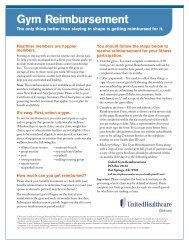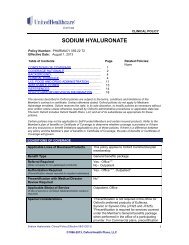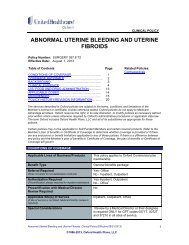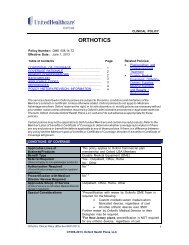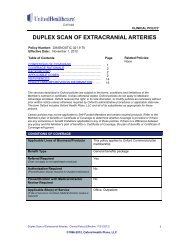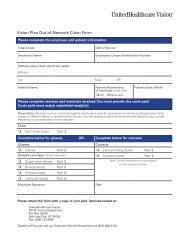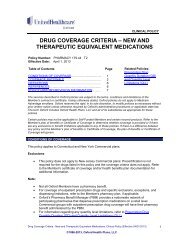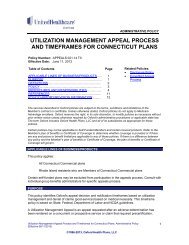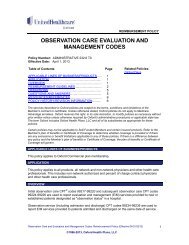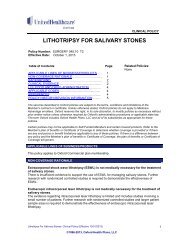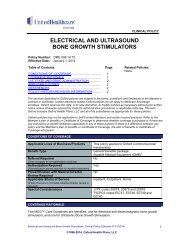AAO has concluded that ICRS inserts are reasonably safe and effective for the treatment of mildmyopia (-1.0 to -3.0 diopters) when patients have stable manifest refraction and less than 1diopter of astigmatism. However, the AAO assessment cautions that further research is neededto determine the long-term effectiveness of this procedure as well as its safety and effectivenesscompared with other treatments such as LASIK and photorefractive keratectomy (Rapuano et al.,2001).The AAO's Preferred Practice Pattern for Refractive Errors and Refractive Surgery states thatintrastromal corneal ring segments are now rarely utilized to correct myopia (AAO, 2007).Keratoconus:Guell et al. (2010) reported the 4-year outcomes after Intacs intrastromal corneal ring segment(ICRS) implantation to correct low myopia in patients with abnormal topography in a retrospectiveconsecutive interventional case series. After ICRS implantation, 82.05% of 39 eyes (21 patients)were within ±1.00 diopter (D) of emmetropia and 46.15% were within ±0.50 D. Refractivecorrection improved during the first 6 months and remained stable up to 4 years. Theinvestigators concluded that 4-year results indicate that ICRS implantation is effective and safe inthe correction of low myopia in patients for whom excimer laser surgery is contraindicatedbecause of abnormal topography, including forme fruste keratoconus. The achieved refractivecorrection remained stable throughout the follow-up.Hellstedt et al. (2005) treated 50 eyes (37 patients) with Intacs and reported that asymmetricIntacs placement improves BSCVA and UCVA and reduces astigmatism in patients with mild tomoderate keratoconus. The authors reported that the procedure is safe and effective and that thechange in astigmatism correction is unpredictable.Colin and Malet (2007) evaluated the use of Intacs in 100 keratoconic eyes 2 years after Intacsplacement. Removal of the segments occurred in 2 eyes due to extrusion and 2 eyes due to poorvisual outcome. At 2 years, of the 82 eyes available for follow-up, UCVA and BCVA improved in80.5% and 68.3% of the eyes, respectively. The investigators concluded that significant andsustained improvements in objective visual outcomes were achieved in most patients.A nonrandomized comparative study and analysis of retrospective data included 17 patients withkeratoconus who had penetrating keratoplasty (PKP) in 1 eye and Intacs implantation in the othereye. Follow-up after PKP was at 24 hours and 6 and 24 months and after Intacs implantation, at24 hours and 3 and 10 months. UCVA and BCVA improved in both groups. No patient lost a lineof acuity. Eyes with Intacs had a shorter recovery time than eyes having PKP. The eyes withIntacs had no complications. Complications in eyes with PKP included cataract, graft rejection,and elevated intraocular pressure. The investigators concluded that Intacs may delay or preventthe need for a corneal graft, although more research with longer follow-up is needed (Rodriguezet al., 2007).Several studies evaluated the use of the Ferrara intrastromal corneal ring (Pesando 2010,Torquetti et al. 2009, Ferrara and Torquietti 2009, Kwitko and Severo, 2004; Ferrara et al. 2011)and the Keraring (de Freitas et al. 2010) for keratoconus. The Ferrara intrastromal corneal ringand the Keraring are not currently approved by the U.S. Food and Drug Administration (FDA).The National Institute for <strong>Health</strong> and Clinical Excellence (NICE) issued guidance on the use ofcorneal implants for keratoconus. The NICE guidance states that current evidence on the safetyand efficacy of corneal implants for keratoconus appears adequate to support the use of thisprocedure (NICE, Corneal implants for keratoconus, 2007).Post-Laser-Assisted In Situ Keratomileusis (LASIK) or Post- Photorefractive Keratectomy(PRK) Ectasia:Intrastromal corneal ring segments have been investigated as a treatment for ectasia after LASIKor PRK. Although early results show potential (Kymionis et al. 2003: n=10 eyes and 1 year followup,Alio et al. 2002: 3 eyes and mean follow-up of 8.3 months, Lovisolo et al. 2002: 4 eyes and 12Intrastromal Corneal Ring Segments: Clinical Policy (Effective 11/01/2013)©1996-2013, <strong>Oxford</strong> <strong>Health</strong> <strong>Plans</strong>, LLC4
to 44 months follow-up, Pokroy et al. 2004: 5 eyes and 9 month follow-up, Siganos et al. 2002: 3eyes and mean follow-up of 8.7 months, Rodríguez et al. 2009: n=7 eyes and 9 monthpostoperative follow-up; Kymionis et al. 2010: 2 patients and 12 month follow-up), the long-termefficacy for this procedure has not been established. Limitations of these studies included smallsample sizes, absence of controlled groups, and short follow-up.Tunc et al. (2011) evaluated the clinical outcomes of intracorneal ring segments (ICRS) (Keraringsegment implantation) in 12 eyes of 10 patients with post- laser-assisted in situ keratomileusis(LASIK) ectasia. The mean preoperative uncorrected distance visual acuity (UDVA) for all eyeswas 1.28 ± 0.59 logarithm of the Minimum Angle of Resolution (logMAR). At 12 months, the meanUDVA was 0.36 ± 0.19 logMAR, and the mean preoperative corrected distance visual acuity(CDVA) was 0.58 ± 0.3 logMAR, which improved to 0.15 ± 0.12 at 1 year. No significant changesin mean central corneal thickness were observed postoperatively and there were no majorcomplications during or after surgery. The authors concluded the ICRS implantation using aunique mechanical dissection technique is a safe and effective treatment for post-LASIK ectasia.According to the authors, study limitations included small sample of treated eyes, the lack ofhigher-order aberration analysis, and the lack of a comparative group.Pinero et al. (2010) evaluated and compared visual, refractive, and corneal aberrometricoutcomes after implantation of 2 types of intrastromal corneal ring segments (ICRS) in eyes withearly to moderate ectatic disease in a retrospective analysis over a 6 month follow-up. The studyincluded consecutive eyes with grade I or grade II corneal ectasia (keratoconus, pellucid marginaldegeneration, ectasia after laser in situ keratomileusis) that had Intacs (Group I) or KeraRings(Group K) ICRS implantation using femtosecond technology. Group I had 17 eyes and Group K,20 eyes. One month postoperatively, there was a statistically significant reduction in sphere inboth groups. At 6 months, there was a statistically significant reduction in manifest cylinder inGroup K that was consistent with the significant reduction in corneal astigmatic aberration. Theuncorrected distance visual acuity increased significantly in Group K but not in Group I; 41.18% ofeyes in Group I and 52.94% in Group K gained 1 or more lines of corrected distance visual acuity.Both groups had significant corneal flattening. At 1 month, the mean primary spherical aberrationwas 0.17 microm ± 0.52 (SD) in Group I and 0.40 ± 0.35 microm in Group K; the difference wasstatistically significant. The investigators concluded that astigmatism correction in early tomoderate ectatic corneas was more limited with the Intacs ICRS, which induced negative primaryspherical aberration in the initial postoperative period. This study is limited by short-term followup.Torquetti and Ferrara (2010) evaluated the clinical outcomes of implantation of Ferraraintrastromal corneal ring segments (ICRS) in patients with corneal ectasia after refractive surgery.Charts of patients with corneal ectasia after refractive surgery were retrospectively reviewed.Twenty-five eyes (20 patients) with corneal ectasia (20 after laser in situ keratomileusis, 4 afterradial keratotomy, 1 after photorefractive keratectomy) were evaluated. Postoperatively, the meanuncorrected distance visual acuity (UDVA) increased from 20/185 to 20/66 and the meancorrected distance visual acuity (CDVA), from 20/125 to 20/40. The investigators concluded thatintrastromal corneal ring segment implantation significantly improved UDVA and CDVA inpatients with corneal ectasia. The short-term follow-up in this study did not allow for assessmentof intermediate and long-term outcomes.Kymionis et al. (2006) reported on the long-term follow-up (5 years) of Intacs for the managementof post-LASIK corneal ectasia in 8 eyes of 5 patients. Refractive stability was maintained for up to5 years in the treatment of post-LASIK corneal ectasia after Intacs implantation. There was noevidence of progressive time-dependent corneal ectasia, late regression, or sight-threateningcomplications in this study. The limitation of this study was its small sample size.Pinero et al. (2009) evaluated the refractive and aberrometric changes in corneas with post-LASIK keratectasia implanted with intracorneal ring segments (ICRS) during a 2-year follow-up ina retrospective, consecutive case series of 25 patients (34 eyes). Uncorrected visual acuity didnot improve after surgery. Best spectacle-corrected visual acuity increased significantly at 6months. Thirty-nine percent of eyes gained 2 or more lines of best spectacle-corrected visualIntrastromal Corneal Ring Segments: Clinical Policy (Effective 11/01/2013)©1996-2013, <strong>Oxford</strong> <strong>Health</strong> <strong>Plans</strong>, LLC5



